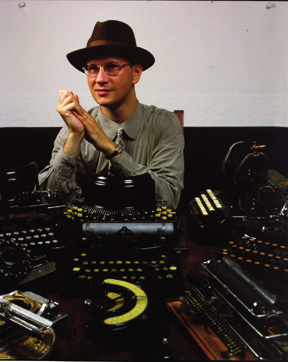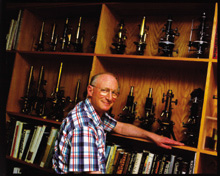Collective
efforts
>>
Tools
of the trade
There
is one word that will get any typewriter collector to emit a sound
like the letter "n" hitting a sheet of onion skin: Crandall.
Inlaid with mother of pearl, trimmed in gold, it's the Cadillac
of typewriters, according to Richard H. Polt, AM'89, PhD'91. And
no, he doesn't have one. But a man can dream, can't he?

Some
beauties Polt does have among the 70-some antique manual typewriters
in his Xavier University office in Cincinnati are a Franklin,
with its sweetly curving ergonomic keyboard patented by Wellington
P. Kidder in 1891, and a 1931 Remington Noiseless Portable No.
7, the proverbial workhorse of the early 20th-century workaday
world. The latter was Polt's first typewriter, rather commonplace
as old manuals go, bought for him by his father at a garage sale
when he was 12 and used faithfully until graduate school. It is
by far his favorite. These days Polt rarely uses a typewriter
unless he's blocked-at which point he bellies up to his Underwood
No. 5. Its hard-to-punch keys, he explains, "make a clackety noise
that makes you feel like you're accomplishing something."

The
fine lines of obsolete state-of-the-art technology also have an
irresistible magnetism for Stuart A. Rice, the Frank P. Hixon
distinguished service professor in the James Franck Institute,
the chemistry department, and the College. "I like to find old
instruments and play with them," says Rice, who began collecting
antique scientific equipment-microscopes, sextants, quintants,
and theodolites (a surveyor's instrument for measuring horizontal
and vertical angles)-in the mid-1970s. His first microscope was
a large, circa-1870 Ross, one of three manufacturers that in the
1850s won a Royal Microscopal Society competition to produce the
world's first microscopes. Like present-day microscopes, the Ross
can magnify specimens at 1,200 to 1,300 times original size-but
the quality of the view leaves a lot to be desired. Rice, who
received a 1999 National Medal of Science and is a member of the
Scientific Instrument Society, says he has always had an eye for
technology.

![]()

